Go Outside And Play.
Here's a puzzle to begin this lesson.
Connect all 9 dots using 4 straight lines without lifting your pen or pencil off the page. Figure 1.

The solution can only be found if you "extend" outside the box. Figure 2.

Last lesson we explored finger combinations "inside the box". Figure 3.
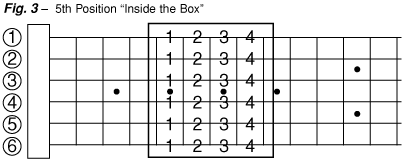
Now, by extending the "1st finger lower" or the "4th finger higher", we can discover combinations "outside the box". Figure 4.
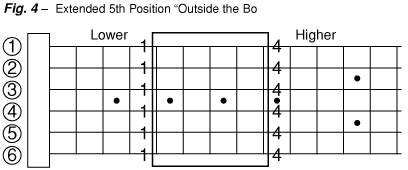
To simplify the illustrations, let's show "inside the box" in a way which may be applied to any string or position. Figure 5.

Figure 6 illustrates "outside the box", which may also be applied to any string or position.

By combining these "inside and outside the box" fingerings, 14 different combinations are reveled!
Figure 7 illustrates 4, "1st finger lower" extensions.
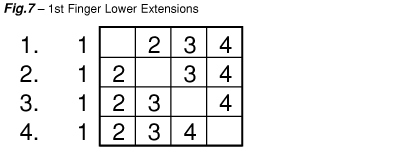
Figure 8 illustrates 4, "4th finger higher" extensions.
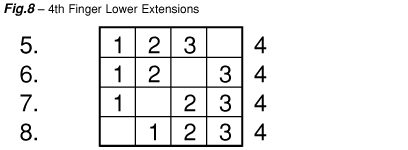
When these lower and higher extensions are combined, 6 more finger combinations are created. Figure 9.
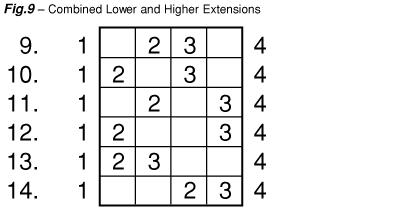
As you play these 14 finger combinations, notice the "space" between your fingers - sometimes one fret and sometimes two or more. This "distance" between your fingers is called an "interval" - a measurement of "sound space"...but that's another lesson...
Did someone say - Fretboard Flashcards?
So till next time, have some fun playing outside, now that you are free from the box.
Return to Proficient Lessons
Connect all 9 dots using 4 straight lines without lifting your pen or pencil off the page. Figure 1.

The solution can only be found if you "extend" outside the box. Figure 2.

Last lesson we explored finger combinations "inside the box". Figure 3.

Now, by extending the "1st finger lower" or the "4th finger higher", we can discover combinations "outside the box". Figure 4.

To simplify the illustrations, let's show "inside the box" in a way which may be applied to any string or position. Figure 5.

Figure 6 illustrates "outside the box", which may also be applied to any string or position.

By combining these "inside and outside the box" fingerings, 14 different combinations are reveled!
Figure 7 illustrates 4, "1st finger lower" extensions.

Figure 8 illustrates 4, "4th finger higher" extensions.

When these lower and higher extensions are combined, 6 more finger combinations are created. Figure 9.

As you play these 14 finger combinations, notice the "space" between your fingers - sometimes one fret and sometimes two or more. This "distance" between your fingers is called an "interval" - a measurement of "sound space"...but that's another lesson...
Did someone say - Fretboard Flashcards?
So till next time, have some fun playing outside, now that you are free from the box.